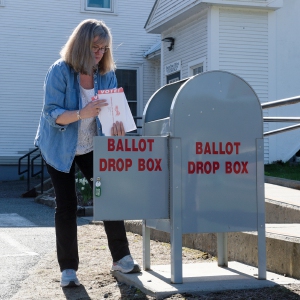Veterans work through health care options, red tape with toxic burn pit exposure law
| Published: 11-05-2022 10:17 PM |
NEWPORT — Mark Murphy recalls once asking his supervisor at Bagram Air Base in Afghanistan what was burning when he noticed a nearby cloud of smoke.
Murphy, 38, who did two deployments with the Air Force between 2006 and 2010, said the supervisor explained: “Oh, they’re burning stuff.”
Refuse on the base was being doused with gasoline and set ablaze.
Murphy, of Newport, said he recalls thinking of the burn pit, which was close to where he and others were working, “doesn’t sound safe,” but he shifted his attention to the electronic warfare tasks that were his duty.
“You do what you need to do and get the job done,” he said. “A lot of the conditions on the bases they were not very sanitary. They could have been a lot better.”
Murphy, who also was deployed to Iraq, was discharged in 2010 after suffering a traumatic brain injury and tearing his right shoulder during his second deployment. He now is a married father of four and owns a construction company.
Since returning to civilian life, he has been diagnosed with post-traumatic stress disorder and sarcoidosis, a rare condition that causes small patches of swollen tissue, called granulomas, to develop in organs. Murphy’s doctors at the U.S. Department of Veterans Affairs in the Jamaica Plain neighborhood of Boston found the granulomas in his lungs, stomach, intestines and heart.
“It was pretty extensive,” he said. “At that time they told me there was no cure. (There was) nothing they could do to treat it.”
Article continues after...
Yesterday's Most Read Articles
 Dartmouth administration faces fierce criticism over protest arrests
Dartmouth administration faces fierce criticism over protest arrests
 Three vie for two Hanover Selectboard seats
Three vie for two Hanover Selectboard seats
 A Look Back: Upper Valley dining scene changes with the times
A Look Back: Upper Valley dining scene changes with the times
 Norwich author and educator sees schools as a reflection of communities
Norwich author and educator sees schools as a reflection of communities
Sarcoidosis, a multi-system inflammatory disease that can lead to organ damage, is among the list of more than 20 burn pit and other toxic exposure presumptive conditions included in the Sgt. 1st Class Heath Robinson Honoring Our Promise to Address Comprehensive Toxics, or PACT, Act of 2022. The act is named for Robinson, who following his deployments to Kosovo and Iraq with the Ohio National Guard developed an autoimmune disorder and lung cancer, both of which are associated with burn pit exposure. He died in 2020 at the age of 39.
As a result of that legislation, which President Joe Biden signed into law in August, Murphy has notified the VA that he plans to apply for additional benefits.
As many as several million veterans nationally, including 9,000 veterans in the catchment area for the White River Junction VA Medical Center, may qualify for additional benefits under the law, Gregory Hartford, chief of the business office at the White River Junction VA , told viewers of a webinar the VA held on the PACT Act last month. The White River Junction VA currently cares for about 30,000 veterans, he said.
Hartford, a Navy combat veteran who served in Afghanistan, described the PACT Act as a “massive piece of legislation” which is “expected to be one of the largest in VA’s history.”
The act expands and extends eligibility for VA health care for veterans who’ve been exposed to toxic materials, and for veterans of Vietnam, the Gulf War and post-9/11 eras.
In addition to sarcoidosis, the more than 20 new presumptive conditions for Gulf War and post-9/11 veterans also includes asthma diagnosed after service; chronic bronchitis; chronic obstructive pulmonary disease; chronic rhinitis and sinusitis; emphysema; and various cancers including those of the brain, gastrointestinal system, head and neck, kidneys, lymphatic system, pancreas, reproductive and respiratory systems, as well as glioblastoma, lymphoma and melanoma, among other conditions.
For Vietnam veterans and other veterans exposed to tactical herbicides such as Agent Orange, the act adds high blood pressure and monoclonal gammopathy of undetermined significance to the list of presumptive conditions. When a condition is presumptive, it means that the veteran doesn’t have to prove to the VA that the condition was service-related; it is presumed to be so.
The PACT Act also adds more presumptive exposure locations for Agent Orange and radiation, and requires that the VA provide toxic exposure screening to every veteran enrolled in VA health care.
Under the act, there is a special health care enrollment period for veterans who served in a combat theater after the Persian Gulf War or in combat against a hostile force after Nov. 11, 1998, and who were discharged between Sept. 11, 2001, and Oct. 1, 2013. Enrolling is free and health care is free for up to 10 years for any condition related to their service.
Beginning with the act’s enactment, Vietnam-era veterans who served in a range of places during different time periods also now qualify to enroll in VA health care. Some Vietnam veterans were previously denied based on where they served.
The law also requires the VA, using a phased-in approach, to provide hospital care, medical services and nursing home care for any illness to veterans who participated in a “toxic exposure risk activity” while on active duty; as well as for veterans who were assigned to certain locations during certain periods of time; and those who were deployed in support of specific operations.
Veterans can apply for the expanded benefits by coming in to the White River Junction VA Medical Center or the Littleton, N.H., VA clinic, or by mailing an application. More information is online at va.gov/PACT.
In addition to the veterans themselves, survivors of veterans may also qualify for additional benefits under the act.
“I’m really proud of this bill,” Hartford said. “... I truly believe in my heart that this is going to positively affect many veterans.”
Don Hayes, director of the Veterans Legal Assistance Project of Vermont at Vermont Law and Graduate School in South Royalton, was among the more than 50 people who logged on to the webinar.
In a phone interview afterward, Hayes said his clinic, which is grant-funded, hasn’t yet seen an uptick in veterans seeking assistance, but he expects it will once veterans apply for additional benefits and some are denied. His office primarily helps with appeals, so Hayes said he expects to see requests for assistance increase in the spring.
He also is helping some veterans with ongoing appeals, who could now file claims under the PACT Act. They now will have to sort out whether to file new claims or continue with their appeals.
“One of the complaints you hear pretty often (about) the VA is (that it’s) difficult to work with,” Hayes said. “Some veterans get frustrated by the process and will give up.”
While the PACT Act may not be perfect, “It goes a long way of acknowledging the illnesses and injuries that are caused by some of these toxic exposures,” he said.
By making more conditions presumed to be service-connected, the PACT Act aims to streamline the process for veterans, Hayes said. It “relieves the veteran of the burden of having to show the nexus between the disability and service,” Hayes said.
Still “the burden in most instances is going to be on the veteran,” he said. Once a veteran is enrolled, the VA has a duty to assist them, but the VA doesn’t make claims on behalf of veterans.
Cathleen Fountain, a 66-year-old Navy veteran, Dalton, N.H., resident and Murphy’s mother, was among those who logged on to the October webinar.
She asked if her son (Murphy), who is already enrolled in VA health care, is “going to need to do anything further if he’s already getting treatment. I want to make sure that he’s getting everything that he needs.”
Marcos Lugo, supervisory veterans service representative with the VA’s White River Junction Regional Office, said yes. While Murphy may already be receiving health care, making his condition service-connected will help cover his costs and affect his co-payments, Lugo said.
In a phone interview following the webinar, Fountain said she tries to help Murphy by “just paying attention and letting him know what’s out there. He does have a bit of (a) memory issue from some of the stuff that happened to him.”
Like Murphy, Claremont resident James England, a 39-year-old Marine Corps veteran who deployed to Iraq twice between 2004 and 2006, also remembers being exposed to burn pits. England now receives care through the VA for service-related anxiety and PTSD.
England said he was part of the country’s volunteer military force and as such had signed up to take risks. Still he said, it “wasn’t the average Marine that wanted to go to Iraq. The government said, ‘We’re going to go do this.’ ”
If the government commits American lives and resources to a conflict, he said, it “should be able to pay the price on the other end.”
England said he sees the PACT Act as a step forward for veterans who do develop lung cancer or other conditions.
“At least it’s a way that they can get treatment,” said England, who volunteers with Veterans of Foreign Wars Post 808 in Claremont. “Versus before where the government said, ‘That’s the cost of doing business.’ ”
But, he said the act is not preventive: “Until you come down with lung cancer you have no way of knowing.”
England said he sees the burn pit manner of trash disposal as a “byproduct of necessity,” but as time went on during his service he did notice that the burn pits moved away from the center of the camp. Meanwhile, Murphy said he thinks the military ought to have had a better plan for how to handle trash in wartime.
“It’s an absolute disgrace,” Murphy said. “The fact that command was allowed to do these things in these countries and not have a game plan in place.”
England said he is on a burn pit registry, which collects information about those who’ve been exposed to understand the health consequences of the exposures. Since he and other veterans have been on the list for a while — it was established in 2014 — England said he’s uncertain of the difference the PACT Act will make for them.
“I don’t think it’s potentially going to have a major impact for your average veteran,” England said, at least in the near term. He predicted it will take a couple of decades to learn the full consequences of the burn pits to veterans’ health as more of them develop symptoms and conditions associated with exposure.
For his part, Murphy said he would like to see the VA reach out to veterans who now qualify for additional benefits based on their time and location of service. He said the VA ought to reach out to veterans with symptoms or conditions that might fall under the PACT Act.
Now that Murphy has filed his intent to file with the VA, he needs to fill out the claim form. He said he’s curious to see how long it takes to wind its way through the bureaucracy.
“Last time I did a disability (claim) it took almost two years,” he said.
Nora Doyle-Burr can be reached at ndoyleburr@vnews.com or 603-727-3213.

 Students take down pro-Palestinian encampment at UVM
Students take down pro-Palestinian encampment at UVM Sharon voters turn back proposal to renovate school
Sharon voters turn back proposal to renovate school
